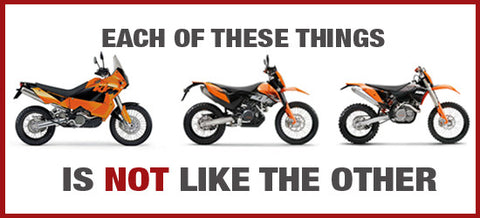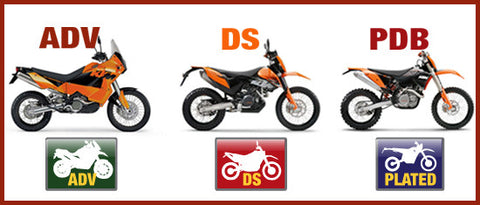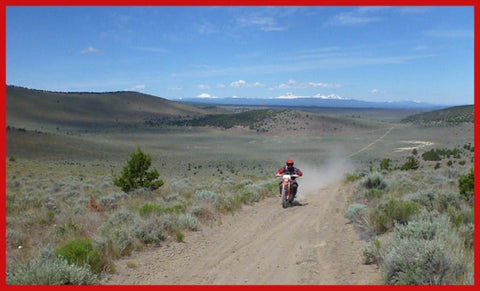Dual Sport or Adventure?
Have you ever been asked "what is the difference between a dual sport and an adventure bike"? It is a common, and very important question. However, there is no accepted definition of what separates an “Adventure" bike from a “Dual Sport" bike from a “plated dirt bike” (PDB in our lingo). This is probably due to the fact that no two people can agree on this. But, The BOMBERS, being the problem solvers they are, set about to create our own. 
First, we don't subscribe to the concept that says "how you use it defines what it is". There is a common opinion that says an adventure bike is defined by the way that one uses it. In other words, if you ride your FatBoy in the woods, then it is an enduro. We like that attitude, however, it contradicts what we need to do our job correctly. ADV riders, Dual Sport riders, and dirt bike riders need to choose gear based on their particular type of riding mission. So, we in the industry need to have category definitions, so we can recommend proper gear (good luck using that MotorCo leather jacket off road, bro...). Some people seem to flip out at the idea of defining "Adventure Bike", but when you get down to it...even when you use a screwdriver to pound a nail, it still ain't a hammer. 
We define Adventure Bikes (or "ADV") bikes as 650ccs and larger, multi cylinders, 400 lbs or more, and with passenger accommodations. ADV bikes are capable of higher speeds, long, steady, sustained time on the road, and if necessary, carrying a passenger. Their frame geometry, suspension, and tires allow them to travel on dirt, but their weight and size make it very challenging to ride on rough terrain. Lifting them up when dropped may be difficult for a single person, which is a limit for backcountry riding. Examples are the BMW GS twins, KTM 1190, Yamaha Super Tenere, Suzuki V-Strom, etc.
ADV riding brings need for serious protection against elements (water, wind, and cold), plus abrasion and impact protection for higher speeds. These goals, especially the protectors, should be integrated into the garment. Gear should fit more snug to the body to minimize rotation in falls, not flap or parachute, and to not allow cold spots. It should seal up snugly and not leak, because at 65 mph for hours on end, all you do is ponder the flaws in your gear.
Admirably Hard Core....
We define "Dual Sport bikes" as 650ccs and less, single cylinder, with enough oil capacity to operate at medium intervals. They are usually 350 lbs or less, with at 10 inches of ground clearance and off road capable suspension. Dual sport bikes can ride fairly technical terrain, which means the riding is more physical. DS bikes are light enough to be picked up by a single person, so they are capable of going much deeper into The Dirty Zone, but are poor for extended time on the road. Carrying a passenger is possible, but is not particularly enjoyable. Examples are the DRz400, WR250R, KTM 690, Honda XR650L, and others.
Dual sport riding involves more technical terrain, which equals more physical exertion which equals an elevated heart rate, body heat, and big swings in body temperatures. Protection against the elements must be weighed against managing heat and exertion. In many cases waterproof construction is a liability. Noise level and perfect wind protection are less important; venting, loose fit, and modular construction (removable sleeves, collar) are desirable. An observation: it is common for dual sport riders to “over gear”....to choose stuff too heavy for physical riding.
Wind noise is really not a concern here.
A third category is "Plated dirt bikes". The BOMBERS say these are 600 ccs or less, <280 lbs, no passenger accommodations, and off road suspension. Their name is the most literal; they are dirt bikes with license plates to make them more convenient. They may be incorrectly described as dual sports, but they are intended for 90% off road use, and only very limited street riding. Examples are the ubiquitous KTM 450 and 530 EXCs, Husqvarna TE310s, and if you live in CO, ID, VT, and AZ, apparently anything with a spark plug.
NOT your fathers DR.....
There are a few bikes that blur these definitions, most notably the lovable / confounding Kawasaki KLR 650, which gets used in all these categories, plus for plowing snow, logging, towing, etc. 
Shape Shifter.
The moto world is also dotted with freak talents like Jimmy Lewis, who can wield a GS like an ego piercing missile to shame people on 125s. This is great, but does that make them the same type of motorcycle? Or, should it be viewed in a contextual sense, meaning people with exceptional ability, taking a bike beyond its typical envelope?
Piece of cake, right?
Agree or disagree, our delineation is carefully considered, solid, and we feel, helpful when researching gear. We hope it helps you.
Undoubtedly, some kook who rides a Fat Boy on MX tracks will emerge, and argue we are completely wrong. Whatever. Our delineation is carefully considered, solid, and should help direct you when choosing gear. The important take aways are....1. there are subtle differences in bikes and riding, and 2. your gear choices need to compliment, not controvert, the design and capabilities of your bike(s).
SUMMARY
Adventure Bikes
- > 650ccs
- Multi cylinders
- 400 lbs or more / may not be able to be lifted by single person if falls over
- Capable of extended road travel in comfort
- Examples: BMW GS twins, KTM 1190, Yamaha Super Tenere, Suzuki V-Strom, etc
Adventure Gear
- Serious protection against wind, rain, cold
- Waterproof construction critical
- Integrated abrasion and impact protection
- Gear should fit snugly
Dual Sport Bikes
- < 650cc
- Single cylinder
- 400 lbs or less
- Can be lifted by a single person
- Capable of rough off road travel, singletrack
- Examples: Suzuki DR650, KTM 690, Honda XR650L, Yamaha WR250R, etc
Dual Sport Gear
- More physical exertion demands more breathability
- Venting, modular construction are critical
- Looser fit
- Waterproof construction can be a liability
- Separate armor recommended
Plated Dirt Bikes
- < 600cc
- Single cylinder
- 280 lbs or less
- Can ride almost any terrain
- Street use as convenience only
- Examples: KTM 450 EXC, KTM 530 EXC, Husqvarna TE310, etc
Plated Dirt Bike Gear
- Best to use regular dirt gear, along with layers and accessories for versatility
- Rain / Cold shells, hydration packs, warmer gloves, etc.
The BOMBERS
Atomic-Moto
- Brian Price